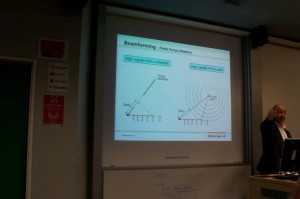The November meeting of the AES Melbourne Section included a presentation on the topic “Noise Source Identification Techniques” by Maurizio Demontis of Brüel & Kjær.
Maurizio first gave us a brief overview of Brüel & Kjær’s activities across noise and vibration measurement applications, as well as the other related activities of other companies within the parent company Spectris.
Then he moved into the specifics of Noise Source Identification – which he described as an engineering tool used to identify and rank noise sources in a range of environments.
He described how in product engineering – both design and manufacturing – noise considerations can be dictated by regulations or by product improvement and the subsequent troubleshooting.
Maurizio explained the two classes of microphone-based Noise Source measuring devices – Sound Intensity probes and multi-microphone arrays. He indicated that the two techniques each have their pros and cons.
The Sound Intensity probes are less expensive, and are very useful for troubleshooting the location of sound leakage- but are time-consuming in use to build up an Acoustic Holography image. The Beam Forming, and Spherical Beam Forming arrays are much more expensive, but can quickly build up the holography image.
One application where the Sound Intensity Probe cannot yet be replaced is in the regulatory quantifying of device acoustic noise levels, as it is the only method currently recognised in international noise standards.
He explained that Noise Source Identification research was originally driven by the automotive & aerospace industries, as they had pressing needs, and the budgets to drive the process.
He also commented that intensity probes and later developments provide information that simple sound pressure level measurements cannot, and provide real improvements in understanding and controlling sources of noise.
Described then various mic arrays using up to 64 microphones, explaining that the size of the array and the spacing of microphones in the array dictate the highest and lowest frequencies and the spatial resolution.
He finished with a short video outlining some case studies on auto, aircraft, wind-farm, and domestic appliance noise source measurement and abatement.
Then he invited questions from the audience and the range of questions and comments indicated the keen interest in the topic.
Related Links:
Webtrak aircraft noise tracker – web-based Melbourne aircraft noise tracker: http://webtrak.bksv.com/mel
Brüel & Kjær Noise Source Identification webpage:
http://www.bksv.com/Applications/NoiseSourceIdentification.aspx
Brüel & Kjær YouTube Channel: http://www.youtube.com/user/BruelKjaerVideo
All of the application segments from the video Maurizio played on the night – and much more.
An audio recording of Maurizio’s presentation is available for listening or downloading here

